
A warehouse is a busy place. Things move fast. Trucks come and go. People operate machines. Goods are stacked high. This energy is good for business, but it can also lead to accidents. Keeping everyone safe is the most important job.
A safe JAFZA warehouse is a productive one. Find here simple ways to maintain high safety standards.
Organize for safety:
A tidy warehouse is a safe warehouse. Keep floors clean and clear of clutter. Ensure nothing is left in walkways or near doors. Put tools and supplies back in their proper places after use. Good organization prevents trips, slips, and falls. It also helps people find what they want quickly, reducing stress and mistakes.
Train everyone well:
Safety starts with knowledge. Every person working in the warehouse must have proper training. This includes knowing how to use equipment like forklifts correctly. It also means knowing the safety rules for their specific tasks. Regular training sessions help keep these rules fresh in everyone’s mind. When people know how to do their jobs safely, accidents are less likely to happen.
Wear the right gear:
Personal Protective Equipment, or PPE, is a simple shield against injury. Make it a rule for everyone to wear the right gear for their job. This can include hard hats to protect heads, safety shoes to protect feet, and high-visibility vests so people are easily seen. Gloves and safety glasses are also important for many tasks. This gear can prevent serious harm.
Inspect equipment often:
Machines and equipment want regular check-ups. A forklift with a bad brake or a ladder with a loose step can cause major problems. Create a schedule to inspect all equipment frequently. Fix any problems immediately. Do not let people use broken tools. This proactive approach stops equipment failures before they can cause an accident.
Clear signs and markings:
Use the power of visual communication. Put up clear signs to warn of potential hazards. Mark walking paths and driving lanes on the floor with bright paint. Designate specific areas for different activities, like loading or storage. Good signs and markings help guide the flow of people and machines, preventing collisions and confusion.
